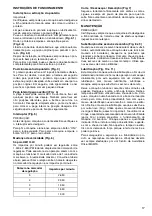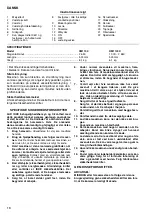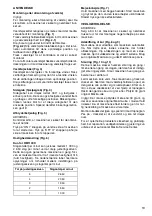
5
OPERATING INSTRUCTIONS
Installing or removing bit
Important:
Always be sure that the tool is switched off and
unplugged before installing or removing the bit.
Clean the bit shank and apply the bit grease provided
to it before installing the bit.
(Fig. 1)
Pull the tool holder cover down all the way and insert
the bit into the tool holder.
(Fig. 2-1)
Turn the bit and push it in until it engages.
(Fig. 2-2)
Release the tool holder cover. It will return automati-
cally to its original position to secure the bit.
(Fig. 2-3)
After installing, always make sure that the bit is
securely held in place by trying to pull it out.
To remove the bit, pull the tool holder cover down all
the way and pull the bit out.
Bit angle (Fig. 3)
The bit can be secured at 16 different angles. To
change the bit angle, slide the change ring forward,
then turn the change ring to change the bit angle. At
the desired angle, slide the change ring back to the
original position. Then turn the change ring slightly so
that the bit will be secured in place with a little click.
Side handle (auxiliary handle) (Fig. 4)
The side handle can be swung 360° on the vertical
and secured at any desired position. It also secures
at eight different positions back and forth on the hori-
zontal. Just loosen the clamp nut to swing the side
handle to a desired position. Then tighten the clamp
nut securely.
Switch action (Fig. 5)
CAUTION:
Before plugging in the tool, always check to see that
the tool is switched off.
To start the tool, push the “ON I” button on the left
side of the tool. To stop the tool, push the “OFF O”
button on the right side of the tool.
Speed change (Fig. 6)
For HM1100C only
The blows per minute can be adjusted between 1,300
and 2,650 BPM just by turning the adjusting dial. This
can be done even while the tool is running. The dial is
marked 1 (lowest speed) to 5 (full speed). Refer to
the table below for the relationship between the num-
ber settings on the adjusting dial and the blows per
minute.
Chipping / Scaling / Demolition (Fig. 7)
Hold the tool firmly with both hands. Turn the tool on
and apply slight pressure on the tool so that the tool
will not bounce around, uncontrolled. Pressing very
hard on the tool will not increase the efficiency.
MAINTENANCE
CAUTION:
Always be sure that the tool is switched off and
unplugged before carrying out any work on the tool.
Replacement of carbon brushes (Fig. 8 & 9)
Whenever carbon brushes must be replaced, they
cut out the tool automatically. When this occurs,
loosen the screws which secure the rear cover. Pry
up the rear cover with a screwdriver and remove it.
Then replace both carbon brushes at the same time.
Use only identical carbon brushes.
Lubrication (Fig. 10 & 11)
This tool requires no hourly or daily lubrication
because it has a grease-packed lubrication system.
Lubricate the tool every time the carbon brushes are
replaced.
Run the tool for several minutes to warm it up. Switch
off and unplug the tool. Remove the crank cap using
a socket wrench. Rest the tool on the table with the
bit end pointing upwards. This will allow the old
grease to collect inside the crank housing. Wipe out
the old grease inside and replace with a fresh grease
(30 g). Use only Makita genuine grease (optional
accessory). Filling with more than the specified
amount of grease (approx. 30 g) can cause faulty
hammering action or tool failure. Fill only with the
specified amount of grease. Reinstall the crank cap
and tighten with the socket wrench. Do not tighten
the crank cap excessively. It is made of resin and is
subject to breakage.
To maintain product safety and reliability, repairs,
maintenance or adjustment should be carried out by
a Makita Authorized Service Center.
Number on adjusting dial
Blows per minute
5
2,650
4
2,350
3
1,950
2
1,550
1
1,300






































